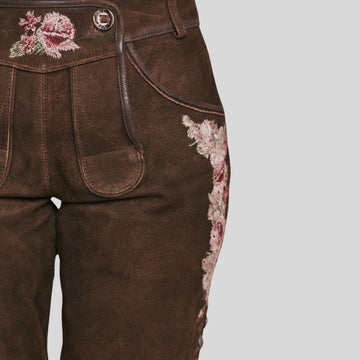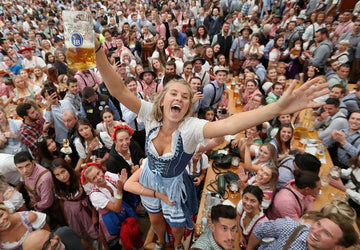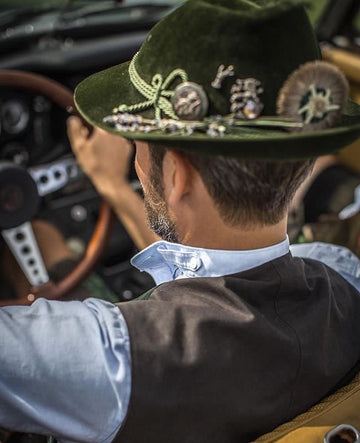Lederhosen are a quintessential element of German traditional clothing, representing a rich cultural heritage that dates back centuries. Originating in the alpine regions of Bavaria and Austria, these distinctive leather breeches have become a symbol of regional pride and tradition.
History and Origins
Lederhosen, literally translating to "leather trousers" in German, were originally designed as durable workwear for peasants and laborers in the mountainous areas of Bavaria and Austria. Crafted from robust leather, these breeches were ideal for the rugged outdoor environment, providing both protection and comfort. Over time, lederhosen transitioned from practical work attire to a staple of festive and traditional occasions.
Early Beginnings
The exact origins of lederhosen are somewhat obscure, but it is widely believed that they have been a part of the alpine culture for over 500 years. Initially, they were utilitarian garments, designed for hard labor. The leather used for lederhosen, typically from deer, goat, or cowhide, was selected for its durability and ability to withstand harsh conditions.
Evolution Over Centuries
As lederhosen became more ingrained in the culture, their design evolved. By the 18th century, they began to incorporate decorative elements such as embroidery and intricate stitching. These additions not only enhanced their aesthetic appeal but also signified social status and regional identity. Wealthier individuals would have more elaborately decorated lederhosen, often tailored to their specific measurements.
The Influence of King Ludwig II
King Ludwig II of Bavaria, a prominent figure in the 19th century, played a significant role in popularizing lederhosen as part of Bavarian traditional dress. His patronage of regional culture and arts helped cement the place of lederhosen in festive attire. Under his influence, lederhosen became a symbol of Bavarian pride, worn during festivals, hunting trips, and social gatherings.
The Lederhosen Outfit

A typical Lederhosen Outfit consists of several key components:
- Lederhosen: The centerpiece, made from high-quality leather, often features intricate embroidery and decorative elements. There are different lengths available, from knee-length to shorter versions known as "shorts" or "plattlerhosen."
- Shirt: Traditionally, a checkered or plain white shirt complements the lederhosen. These shirts are usually made of cotton or linen, providing a comfortable and breathable fit.
- Suspenders: Also known as "hosenträger," suspenders are a crucial part of the lederhosen outfit, helping to keep the trousers in place. They often feature elaborate designs and embroidery that add to the overall aesthetic.
- Footwear: Sturdy, traditional shoes or boots, often made of leather, complete the outfit. Socks, typically woolen and sometimes adorned with decorative elements, are worn to provide both warmth and style.
- Accessories: To enhance the lederhosen outfit, accessories like hats (often adorned with feathers), belts, and traditional jackets (such as the "janker") are worn.
Detailed Look at Each Component
Lederhosen: The leather used in lederhosen can vary in type and quality. Deer leather is highly prized for its softness and durability, making it a preferred choice for high-quality lederhosen. Goatskin and cowhide are also commonly used. The length of the lederhosen can indicate the wearer's purpose and occasion. Knee-length lederhosen are more formal and are often worn during festivals and formal gatherings, while shorter versions are suitable for casual settings.
Shirt: The shirt worn with lederhosen is typically a button-up with long sleeves. Checkered patterns in colors like red, blue, and green are traditional, but plain white shirts are also common. The material is usually cotton or linen, chosen for its breathability and comfort, making it ideal for long days at festivals like Oktoberfest.
Suspenders: Suspenders not only hold up the lederhosen but also serve as a decorative element. They are often embellished with embroidery that can include family crests, regional motifs, or floral designs. Suspenders can be cross-back or straight-back and are usually attached to the lederhosen with buttons.
Footwear: Traditional footwear includes Haferlschuh, a type of shoe designed specifically for wearing with lederhosen. These shoes are made of leather and feature a side lacing system. They are sturdy and durable, designed to withstand outdoor activities. Woolen socks, often knee-high and with intricate patterns, are worn with the shoes.
Accessories: Accessories such as the Gamsbart (a tuft of chamois hair) attached to hats, belts with decorative buckles, and the Trachtenjanker (a traditional jacket) add to the authenticity of the lederhosen outfit. These accessories are often handmade and can be passed down through generations as family heirlooms.
Cultural Significance
Lederhosen hold a special place in the hearts of many Germans and Austrians, symbolizing a connection to their ancestral roots and cultural heritage. These garments are prominently featured during festivals and celebrations, most notably during Oktoberfest, the world-renowned beer festival held annually in Munich. During such events, both locals and visitors don their lederhosen with pride, showcasing the timeless appeal of this German Traditional Clothing.
Oktoberfest and Beyond
Oktoberfest is the most famous event where lederhosen are worn, attracting millions of visitors from around the world. The festival, which originated in 1810 to celebrate the marriage of Crown Prince Ludwig (later King Ludwig I) and Princess Therese, has grown into a global phenomenon. Lederhosen are the standard attire for men attending Oktoberfest, while women often wear dirndls, a traditional dress.
However, lederhosen are not confined to Oktoberfest. They are worn at various other festivals, including regional events like the Cannstatter Volksfest in Stuttgart and the Gäubodenvolksfest in Straubing. Additionally, they are a popular choice for weddings, cultural festivals, and even as casual wear in some regions.
Modern Adaptations
While lederhosen remain steeped in tradition, modern adaptations have emerged, making them accessible to a broader audience. Contemporary versions may incorporate various colors, slimmer fits, and unique patterns, appealing to those looking to blend tradition with modern fashion trends. Whether worn for cultural festivities, themed parties, or as a unique fashion statement, lederhosen continue to capture the imagination of people around the world.
Fashion Forward
In recent years, designers have reimagined lederhosen to suit contemporary tastes. Slimmer fits, alternative materials, and innovative patterns have been introduced, allowing lederhosen to appeal to a younger, more fashion-conscious audience. These modern lederhosen are often seen on runways and in fashion magazines, bridging the gap between tradition and modernity.
Celebrity Influence
Celebrities have also played a role in popularizing lederhosen. Figures such as Arnold Schwarzenegger, Gerard Butler, and even Usain Bolt have been spotted wearing lederhosen, bringing international attention to this traditional garment. Their endorsement has helped elevate lederhosen from regional attire to a global fashion statement.
How to Choose the Perfect Lederhosen?

Selecting the right lederhosen involves considering several factors, including fit, material, and design. Here are some tips to help you choose the perfect lederhosen outfit:
- Fit: Ensure the lederhosen fit comfortably around the waist and thighs. They should not be too tight or too loose. Consider the length based on the occasion and personal preference.
- Material: Choose high-quality leather, such as goatskin or cowhide. The quality of the leather affects the durability and comfort of the lederhosen.
- Design: Look for embroidery and decorative elements that reflect your personal style. Traditional motifs and patterns add to the authenticity and appeal.
- Accessories: Complement your lederhosen with appropriate accessories, including a traditional shirt, suspenders, footwear, and hats.
- Purpose: Consider the occasion for which you are purchasing lederhosen. For formal events and festivals, traditional styles are preferred, while modern adaptations may be suitable for casual wear.
Care and Maintenance
Proper care and maintenance of lederhosen are essential to preserve their appearance and longevity. Here are some tips to keep your lederhosen looking new:
- Cleaning: Use a damp cloth to wipe off dirt and stains. Avoid using harsh chemicals or soaking the lederhosen in water.
- Storage: Store lederhosen in a cool, dry place. Avoid direct sunlight, which can cause the leather to fade and crack.
- Conditioning: Regularly condition the leather to keep it supple and prevent drying. Use a leather conditioner specifically designed for garments.
- Repair: If there are any tears or damage, seek professional repair services to restore the lederhosen to their original condition.
Conclusion
In conclusion, lederhosen are more than just a piece of clothing; they are a symbol of German traditional clothing and cultural identity. The lederhosen outfit, with its intricate designs and historical significance, remains a cherished part of Bavarian and Austrian heritage. Whether you're attending Oktoberfest or exploring your cultural roots, donning a lederhosen outfit is a way to celebrate and honor this timeless tradition.
With their rich history, cultural significance, and modern adaptations, lederhosen continue to be a beloved and iconic garment. By choosing the right lederhosen and caring for them properly, you can enjoy this traditional attire for years to come.




